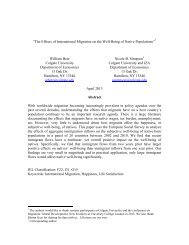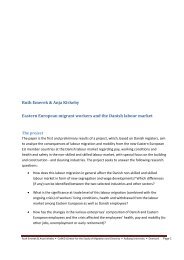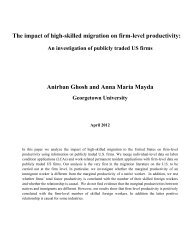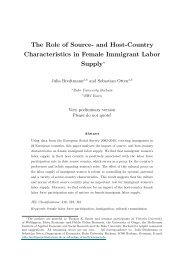La politique française de co-développement - CReAM
La politique française de co-développement - CReAM
La politique française de co-développement - CReAM
Create successful ePaper yourself
Turn your PDF publications into a flip-book with our unique Google optimized e-Paper software.
2. Rethinking integration in the South<br />
The notion of integration in the South needs to be analysed from a different angle than in South-<br />
North <strong>co</strong>ntexts. In many <strong>de</strong>veloping <strong>co</strong>untries, even local populations do not have access to formal<br />
employment, <strong>de</strong>cent housing or social protection. In these <strong>co</strong>nditions, how can public authorities<br />
provi<strong>de</strong> immigrants with services not even affor<strong>de</strong>d to their own citizens? At the same time, the<br />
absence of a <strong>co</strong>mprehensive welfare state in many <strong>de</strong>veloping <strong>co</strong>untries lowers e<strong>co</strong>nomic and social<br />
discrepancies between foreign-born and local-born populations and makes integration less of a<br />
central issue. But this does not mean that immigrants in the South do not face specific problems that<br />
affect their living and working <strong>co</strong>nditions.<br />
2.1. A diversity of situations<br />
The notion of South implies a diversity of situations, which affects the notion itself of integration. The<br />
South is geographically diverse, and immigrants face very different challenges ac<strong>co</strong>rding to whether<br />
they settle in Africa, in Asia or in <strong>La</strong>tin America. Even within these regions, geographic and<br />
<strong>de</strong>mographic differences are <strong>co</strong>nsi<strong>de</strong>rable. The dichotomy between rural and urban settlements,<br />
<strong>co</strong>upled with the population <strong>de</strong>nsity in migrant-receiving areas, is particularly significant in terms of<br />
immigrant integration.<br />
The geographic diversity of the South is related to culture. Even though a significant share of<br />
migration between <strong>de</strong>veloping <strong>co</strong>untries <strong>co</strong>nsists of intra-regional flows, primarily in Africa, cultural<br />
differences between <strong>co</strong>untries of origin and <strong>de</strong>stination remain significant. The diversification of<br />
flows and the subsequent increase in inter<strong>co</strong>ntinental South-South migration implies growing<br />
cultural differences between immigrants and native populations, which may slow-down the<br />
integration process (Amor, 2010; Lucassen, 2005; Ozyurt, 2009).<br />
Political diversity is also particularly manifest in the South, and immigrants can equally be found in<br />
<strong>de</strong>mocracies as in autocratic regimes. The opportunities in terms of civil integration are obviously<br />
higher in the former than the latter. Female immigrants are also more likely to move where<br />
inequalities between men are women are lower (see box 1). The fact that immigrants are more<br />
prone to head to politically stable <strong>co</strong>untries, particularly refugees, does not mean that unstable<br />
<strong>co</strong>untries do not attract immigrants. This is notably the case of resource-rich <strong>co</strong>untries, where<br />
immigration <strong>co</strong>exists with civil unrest and low levels of freedom.<br />
Finally, the South is characterised by strong e<strong>co</strong>nomic diversity. “Developing e<strong>co</strong>nomies” en<strong>co</strong>mpass<br />
a wi<strong>de</strong> range of e<strong>co</strong>nomic situations. High-in<strong>co</strong>me <strong>co</strong>untries, in particular major oil and<br />
manufacturing exporters, are placed alongsi<strong>de</strong> extremely poor <strong>co</strong>untries. This affects the living<br />
<strong>co</strong>nditions of immigrants, as migrants in rich <strong>co</strong>untries benefit from better labour opportunities than<br />
those in low-in<strong>co</strong>me <strong>co</strong>untries. However, immigrants choose their <strong>de</strong>stination ac<strong>co</strong>rding to their own<br />
characteristics. In other words, the poorest migrants tend to go to the poorest – and closest –<br />
<strong>co</strong>untries, hence reducing the possibilities of socioe<strong>co</strong>nomic mobility associated with migration. By<br />
<strong>co</strong>ntrast, the wealthiest migrants, characterised by high initial levels of financial and human capital,<br />
move to richer <strong>co</strong>untries, and therefore benefit from the best opportunities. They also have a higher<br />
probability of integrating into their host societies (Hawkins, 2011; Munz et al., 2007; Syed, 2008).<br />
9







